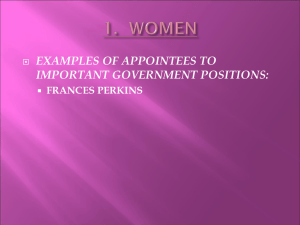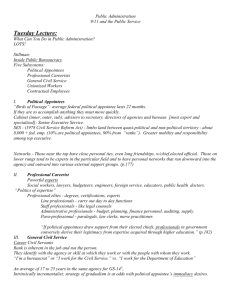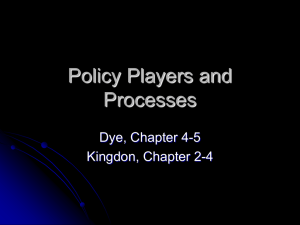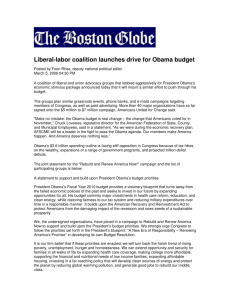Obama's Presidential Appointments to Date
advertisement
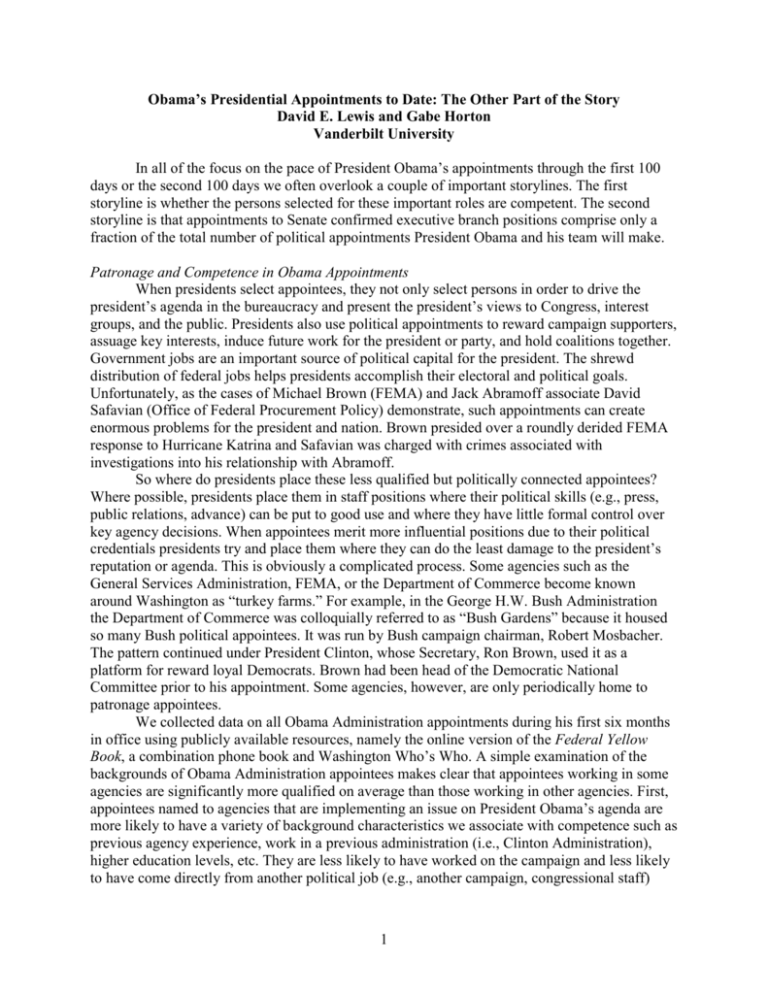
Obama’s Presidential Appointments to Date: The Other Part of the Story David E. Lewis and Gabe Horton Vanderbilt University In all of the focus on the pace of President Obama’s appointments through the first 100 days or the second 100 days we often overlook a couple of important storylines. The first storyline is whether the persons selected for these important roles are competent. The second storyline is that appointments to Senate confirmed executive branch positions comprise only a fraction of the total number of political appointments President Obama and his team will make. Patronage and Competence in Obama Appointments When presidents select appointees, they not only select persons in order to drive the president’s agenda in the bureaucracy and present the president’s views to Congress, interest groups, and the public. Presidents also use political appointments to reward campaign supporters, assuage key interests, induce future work for the president or party, and hold coalitions together. Government jobs are an important source of political capital for the president. The shrewd distribution of federal jobs helps presidents accomplish their electoral and political goals. Unfortunately, as the cases of Michael Brown (FEMA) and Jack Abramoff associate David Safavian (Office of Federal Procurement Policy) demonstrate, such appointments can create enormous problems for the president and nation. Brown presided over a roundly derided FEMA response to Hurricane Katrina and Safavian was charged with crimes associated with investigations into his relationship with Abramoff. So where do presidents place these less qualified but politically connected appointees? Where possible, presidents place them in staff positions where their political skills (e.g., press, public relations, advance) can be put to good use and where they have little formal control over key agency decisions. When appointees merit more influential positions due to their political credentials presidents try and place them where they can do the least damage to the president’s reputation or agenda. This is obviously a complicated process. Some agencies such as the General Services Administration, FEMA, or the Department of Commerce become known around Washington as “turkey farms.” For example, in the George H.W. Bush Administration the Department of Commerce was colloquially referred to as “Bush Gardens” because it housed so many Bush political appointees. It was run by Bush campaign chairman, Robert Mosbacher. The pattern continued under President Clinton, whose Secretary, Ron Brown, used it as a platform for reward loyal Democrats. Brown had been head of the Democratic National Committee prior to his appointment. Some agencies, however, are only periodically home to patronage appointees. We collected data on all Obama Administration appointments during his first six months in office using publicly available resources, namely the online version of the Federal Yellow Book, a combination phone book and Washington Who’s Who. A simple examination of the backgrounds of Obama Administration appointees makes clear that appointees working in some agencies are significantly more qualified on average than those working in other agencies. First, appointees named to agencies that are implementing an issue on President Obama’s agenda are more likely to have a variety of background characteristics we associate with competence such as previous agency experience, work in a previous administration (i.e., Clinton Administration), higher education levels, etc. They are less likely to have worked on the campaign and less likely to have come directly from another political job (e.g., another campaign, congressional staff) 1 Lewis and Horton 2 prior to their appointment. Rather, they are more likely to have been drawn from non-political government work, the military, academia, or industry. Those appointees working in agencies that are not responsible for key Obama priorities, however, are less likely to have strong credentials and more likely to have worked on the campaign or in politics prior to their appointment. The results are troubling for agencies off the president’s agenda and particularly troubling for agencies that spend long periods off the president’s agenda. A second pattern emerging in the Obama appointments is that many less qualified but politically connected appointees are clustering in agencies that are generally liberal in their orientation such as social welfare and regulatory agencies (e.g., Labor, Housing and Urban Development, EPA). Appointees in agencies generally considered to be moderate (e.g., Transportation or NASA) or conservative (e.g., Defense, Treasury, Small Business Administration) are more likely to have previous agency experience, federal government experience, and they have higher average education levels. Persons appointed to conservative agencies are less likely to have worked on the campaign or to have come from a political job. One reason political scientists theorize that such patterns emerge is that potential Democratic patronage appointees prefer jobs in agencies that will advance their career prospects within the party or the constellation of groups around the party and for Democrats this is jobs in Labor, Housing and Urban Development, EPA, etc. Democratic appointees are also best qualified for these jobs. This coincides with the president’s interests since presidents need many of their best qualified appointees to run agencies that do not share the president’s views. As one former Reagan Administration official explained, “We did give more emphasis to those agencies [social welfare agencies] because we expected more bureaucratic resistance from them as a natural result of our agenda…We did not target [agencies concerned with] defense since we knew their bureaucrac[ies] would like what we were doing.” Presidents need appointees with the “right” views to run these agencies but also appointees who know how to run a good government bureaucracy. There were some notable exceptions to these general patterns. Almost one half of the major donors and bundlers who were appointed were appointed to ambassadorships. Some of the more notable appointments were to the ambassadorship in the United Kingdom, Japan, and the Bahamas. Historically, between 30 and 40 percent of ambassadorships, usually the most attractive postings, have been selected by the White House while the remainder has been filled by career foreign service officers. Other agencies that were notable homes to significant numbers of major donors were the Departments of Commerce and Justice. In the current Commerce Department major donors fill positions such as Under Secretary for International Trade, Deputy General Counsel, and head of the Minority Business Development Agency. This is not surprising given the department’s history as a home for major donors. In the last administration, the first department secretary was wealthy businessman Lewis and Horton 3 Don Evans, chair of the Bush/Cheney 2000 campaign. Evans was succeeded by former Kellogg Company CEO, Carlos Gutierrez. In the Justice Department major donors include many of the department’s top officials, including Attorney General Eric Holder, Deputy Attorney General David Ogden, Associate Attorney General Thomas Perrelli, and Solicitor General Elena Kagan. Commerce and Justice may be emerging as the home for major donors because they contain positions that are well paid in the private sector—business, economics, law. In the case of Justice, however, many of Obama’s appointees had strong public objections to the Bush Administration’s handling of the agency perhaps joined the campaign and administration partly to influence its future direction. These attorneys had the means and motivation to give and raise significant money for the campaign. Obama’s Other Appointments While we justifiably focus on the key 500 or so Senate-confirmed positions that include secretaries, deputy, under, and assistant secretaries, these comprise only a portion of the total number of appointments being made by the Obama Administration. At the six month mark the Obama Administration had named 370 Senate-confirmed appointees, 380 appointees in the Senior Executive Service (SES), and 557 Schedule C appointees. This does not include appointments to White House positions, advisory commissions, or legislative or judicial branch appointments. Appointments to these lower positions can be as consequential as appointments to Senate-confirmed positions because they often have direct influence over program management and can be the source of tawdry scandals. Previous political science research demonstrates that federal programs run by appointees perform systematically worse than programs administered by career professionals, partly because of a disparity in background training and experience. These lower level appointees are also frequently the source of scandal. For example, in the last administration John Deutsch (NASA censoring of science) was a Schedule C appointee and Monica Goodling (politicization of Justice Department hiring) and Kyle Sampson (US attorneys firing) were appointees in the Senior Executive Service. It is worth knowing who is being selected for such positions in this administration.

